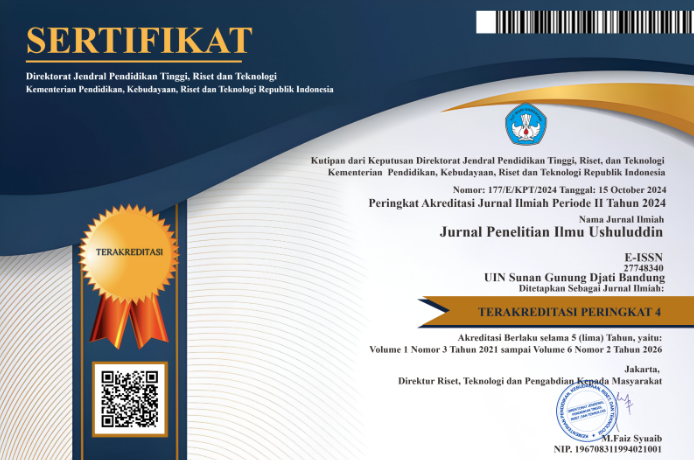Takwil Al-Qur’an Syi’ah Isma’iliyah: Studi Penakwilan pada Kisah Nabi Isa As
DOI:
https://doi.org/10.15575/jpiu.24629Keywords:
Al-Qur’an, Isma’iliyah, Tafsir Asas al-Ta’wilAbstract
This research is about the Shia Sect. The development of Shia is divided into three, including: Itsna 'Asyariyah, Isma'iliyah and Zaidiyah. Shia Isma'iliyah is the second largest sect. The development of Shia is very rapid but requires a long and complex time. The interpretation that is very popular among the Shia is the Tafsir Asas al-Ta'wil. The purpose of this research is to popularize the rarely known Shia interpretation. This research provides an overview of the Ismaili Shia figures, the meaning of ta’wil and the difference with the term tafsir. Then, covered with examples of interpretation of the story of Prophet Isa As. This type of research is classified as qualitative by relying on written data. The result of this research and discussion is that the book Tafsir Asas al-Ta’wil by al-Nu'man ibn Hayyun is the basic basis of mysticism philosophy as an understanding of a nature contained in the Al-Qur’an. It is divided into six sections which interpret the stories of the prophets in the Al-Qur’an, including: Prophet Adam, Prophet Noah, Prophet Abraham, Prophet Musa, Prophet Isa, and Prophet Muhammad SAW. The concept of ta'wil according to Syi'ah Isma'iliyah is an attempt to find the inner meaning or sign, essence, and truth (meaning) that is hidden behind the lafadz. There are many shortcomings in this research. Therefore, Drivers of Islamic Studies are expected to continue to deepen research related to the Ismaili Shia Theme.
References
Al-Nu’man, I. H. (1998). Kitab Asas Al-Takwil. Dar al-Saqafa.
Albi, A., & Setiawan, J. (2018). Metodologi Penelitian Kualitatif. In E. D. Lestari (Ed.), Sukabumi: CV Jejak (1st ed., Vol. 245). CV Jejak.
Bin Jarir al-Thabary, A. J. M. (1988). Tafsir Ath-Thabary 5. Dar al-Fikr.
Chandra, P. (2020). Pendidikan Islam Pada Masa Kebangkitan (Gerakan Intelektual Muslim di Kalangan Syiah Isma’iliyah dan Dinasti Safawy). Jurnal Pendidikan" EDUKASIA MULTIKULTURA", 1(1).
Fazlurrahman. (1984). Islam (Penerjemah: Ahsin Muhammad). Penerbit Mizan.
ḤaiyÅ«n, an-N. b. M. I., & TÄmir, Ä€. (1960). Muqaddamah Asas at-ta’wil. Dar al-Taqafah.
Husen, M. (2021). Theologi Kebatinan Nu ‘MÄn Ibn ḤayyÅ«n dalam Penafsiran SafÄ«nah dan Fulk pada Kitab AsÄs At-Ta’wÄ«l. Al-Fanar: Jurnal Ilmu Al-Qur’an Dan Tafsir, 4(1), 89–112.
Ismatulloh, A. M. (2012). Konsepsi Ibnu Jarir Al-Tabari Tentang Al-Qur’an, Tafsir Dan Ta’wil. FENOMENA, 4(2).
Kemalasari, A. R. R. (2022). Syiah Isma’iliyah dan Syiah Itsna ‘Asyariah:(Pengertian, Konsep Imamah dan Ajaran Lainnya). Jurnal Hukum Lex Generalis, 3(2), 85-101.
Kementrian RI, A. (2007). Al-Qur’an Tikrar & Terjemah. PT Sygma Examedia Arkanleema.
Musonnif, A. (2016). Pemikiran Shi’ah Isma’iliyah tentang Kalender Islam Tinjauan atas Sistem Kalender Hisabi Dinasti Fatimiyah. Kontemplasi: Jurnal Ilmu-Ilmu Ushuluddin, 4(2), 231–252.
Razzaq, A., & Saputra, D. M. (2016). Studi Analisis Komparatif Antara Ta’wil dan Hermeneutika dalam Penafsiran Al-Qur’an. Wardah, 17(2), 89–114.
Yusuf, A. M. (2013). Metodologi Penelitian: Kuantitatif, kualitatif, dan penelitian pengembangan. Padang: UNP Press.
Zulki, A. (2017). Komparasi Tafsir Isyari antara Ahlussunnah dan Syi’ah. Institut PTIQ Jakarta.
Downloads
Published
Issue
Section
License
Authors who publish in Jurnal Penelitian Ilmu Ushuluddin agree to the following terms:
- Authors retain copyright and grant the journal right of first publication with the work simultaneously licensed under an Attribution-ShareAlike 4.0 International (CC BY-SA 4.0) License that allows others to share the work with an acknowledgment of the work's authorship and initial publication in this journal.
- Authors are able to enter into separate, additional contractual arrangements for the non-exclusive distribution of the journal's published version of the work (e.g., post it to an institutional repository or publish it in a book), with an acknowledgment of its initial publication in this journal.
- Authors are permitted and encouraged to post their work online (e.g., in institutional repositories or on their website) prior to and during the submission process, as it can lead to productive exchanges, as well as earlier and greater citation of published work (See The Effect of Open Access).












